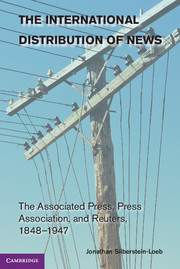 The International Distribution of News
The International Distribution of News Book contents
- Frontmatter
- Dedication
- Contents
- List of Tables
- Acknowledgments
- 1 Introduction
- 2 Conceiving Cooperation among American Newspapers, 1848–1892
- 3 Cooperation, Competition, and Regulation in the United States, 1893–1945
- 4 The “Rationalist Illusion,” the Post Office, and the Press, 1868–1913
- 5 Private Enterprise, Public Monopoly, and the Preservation of Cooperation in Britain, 1914–1941
- 6 Reluctant Imperialist? Reuters in the British Empire, 1851–1947
- 7 Cartel or Free Trade: Supplying the World’s News, 1856–1947
- 8 Conclusion
- Bibliography
- Index
- References
1 - Introduction
Published online by Cambridge University Press: 05 July 2014
- Frontmatter
- Dedication
- Contents
- List of Tables
- Acknowledgments
- 1 Introduction
- 2 Conceiving Cooperation among American Newspapers, 1848–1892
- 3 Cooperation, Competition, and Regulation in the United States, 1893–1945
- 4 The “Rationalist Illusion,” the Post Office, and the Press, 1868–1913
- 5 Private Enterprise, Public Monopoly, and the Preservation of Cooperation in Britain, 1914–1941
- 6 Reluctant Imperialist? Reuters in the British Empire, 1851–1947
- 7 Cartel or Free Trade: Supplying the World’s News, 1856–1947
- 8 Conclusion
- Bibliography
- Index
- References
Summary
For centuries the supply of news has been protected from market forces. Various institutional arrangements have provided protection by subsidizing the provision of news. Direct government grants or subventions have been relatively rare. Although at various times during the nineteenth century political patronage of the press was commonplace in Britain and the United States, rarely was it sustained. Instead, subsidies were largely indirect. A classic example, about which much has been written, is postal subsidies for the distribution of newspapers. Postal subsidies have a long history stretching back to seventeenth-century England. A group of post office officials called the Clerks of the Road could frank newspapers for domestic and foreign distribution, which were then free from postage. For this service they charged newspapers a small fee, which they pocketed personally. In the American colonies and later in the United States, the Post Office also subsidized the distribution of newspapers. With successive developments in telecommunications, such as telegraphy and radio broadcasting, new institutional arrangements were devised that protected the supply of news. The twin subsidies of cooperation and exclusivity and the way in which state action and business activities shaped these subsidies are the focus of this book. Looking closely at the processes by which newspapers obtained news provides a clearer sense of how the supply of news was funded.
Cooperation subsidized the supply of news in two ways. First, by cooperating, newspaper publishers could share with each other the costs of gathering news. During the 1850s and 1860s, the promise of reduced telegraphy costs encouraged newspapers around the world to form associations to collect news. These associations occupied the top of the news pyramid. They supplied reports of breaking news to newspapers and other news outlets such as newsrooms and later radio stations. In turn, these reports either formed the basis for further reporting or were reproduced verbatim. The British Press Association (PA), established in 1868, is the oldest surviving news association. The American Associated Press (AP), incorporated in 1892, grew out of several regional news associations that emerged across the United States during the 1840s, 1850s, and 1860s. In these associations the cost of collecting the news was apportioned among the members of the association according to their respective use of the news reports. The assessments levied on the newspapers were in turn used to meet the costs of supplying the news.
- Type
- Chapter
- Information
- The International Distribution of NewsThe Associated Press, Press Association, and Reuters, 1848–1947, pp. 1 - 8Publisher: Cambridge University PressPrint publication year: 2014
References
- 1
- Cited by
